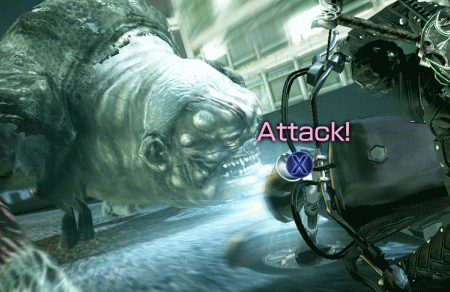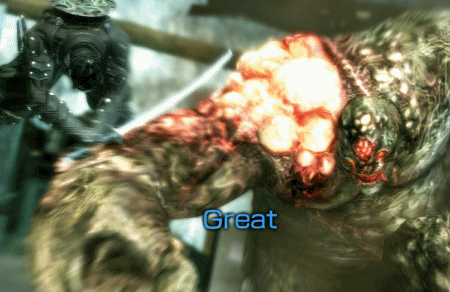 Review: Ninja Blade
Review: Ninja Blade

Hack and Slash
Tenchu’s little brother seems to have spent far too much time playing Shenmue.
![]()
Gareth
Ninjas are cool, that’s a fact all people understand. From Software seem to understand it, having brought us the more recent versions of the Tenchu series, and here they’re trying to create a new Ninja hero in Ken Ogawa, the star of Ninja Blade. Ken is a very different ninja to those you find in Tenchu. Far more Ryu Hayabusa than Rikimaru, he prefers the ‘beat the crap out of demons whilst flipping about’ technique of killing rather than the stealthy approach. It’s quite fitting that I mention Ryu, as Ninja Gaiden seems to have been a very strong influence on Ninja Blade. Ninjas in the future, fighting demons, wall running, finishing moves, even certain attacks are strikingly similar. However, Ninja Blade is quite a different game too, and I won’t hold its similarities with a game I enjoy against it.

If you lined up 300 or so screen prints of this game and threw a dart blindfolded at them, you'd probably hit a QTE screen.
From comparisons to Ninja Gaiden you’ll hopefully have gathered that this is a hack and slash game, but more akin to God of War than Ninja Gaiden or Devil May Cry. Whereas NG can be almost balletic as you block and dodge waiting for the opportune moment to strike Ninja Blade is more about switching to the right weapon (on the fly) for the job and tapping X, with a bit of Y thrown in here and there. The combos in NB are very, very simplistic. They start off as X, X, X, X and although you can unlock new moves as you upgrade weapons, they are generally stand alone moves, some of which are far more useful than others.
You also have access to Ninjitsu and Ninja Vision. Ninjitsu is primarily used for clearing paths (e.g. wind puts out fire) but can be quite useful in a scrap at times, Ninja Vision allows you to slow time which has many uses, but also helps you to see weak spots and other points of interest.
Although Ninja Blade is a hack and slash ’em up at heart, there is another genre in there fighting for supremacy. Interactive movies are back. Quick Time Events (QTEs) are incredibly prominent in Ninja Blade, making up a large portion of the game. These cinematic sequences have been created by Japanese anime studio Production I.G (Ghost in the Shell) and can be quite cool in a “This is so stupid it’s awesome!†kind of way.
Representations of buttons appear on the screen and you have to react quickly by pressing said button in time. Failure to do so does not result in death in Ninja Blade, but simply makes the scene rewind and you start again. There are plenty of chances for gruesome/comedic deaths when you mess up a la Resident Evil 4 or Tomb Raider Legend but instead the action simply stops and rewinds. This is both good and bad. Good because dying would mean restarting at the last checkpoint, which Ninja Blade is pretty generous with so would probably only be a second or two before the QTE anyway. Bad because it removes any challenge (the button sequences are always the same on Normal) and it takes away the feel that you are actually influencing the action.

... You'd probably hit a boss battle too.
There is a boss at the end of each level (and quite a few minibosses as well) which has to be finished off with a (you guessed it) QTE, and as you’d expect from this type of game, the same bosses make an appearance again later on. There are also a few turret sections either on the side of a helicopter or on the back of a truck which are fun if nothing amazing, and a strange running down the side of a building minigame which doesn’t really have a purpose from what I can make out. Ninja Blade doesn’t do anything new, it takes a lot from Ninja Gaiden, and little bits here and there from many other games. Hardly glowing praise, but not a negative in itself. These are some negatives:
|
Rich Secondary Review From Software’s latest ninja adventure (they previously made Tenchu Z) is a low budget mish-mash of hack and slashy action, a glut of QTEs and more boss battles than you can shake a copy of Conan at. A recipe for certain hatred but, oddly, I rather like it. The game has its share of problems with hour long levels (with no mid-level saves) and fairly one-dimensional gameplay but if you’re a fan of the genre then you may find that the over the top action and graphical splendour may win you over. If you can accept that every cutscene involves a QTE you may find yourself blown away by many of them and Ken’s wide range of equipment and attacks makes this one worth picking up on the cheap. Secondary Score: 6/10 |
Certain missions will load in a new section of the level without warning, and by that I mean you’ll be running down a corridor and the game will freeze, only for you to magically appear in a completely different room filled with demons. The framerate can sometimes slow to a complete crawl when there is a lot going on. Enemies ability to shoot you off instant death platforms, bosses continue to live and attack after their health bar is emptied and Ken is a pretty horrible hero. He does some amazing things in the QTEs, and yet he comes across as kind of clumsy and very forgettable. This is probably thanks in part to the design which looks like a cross between Ryu from NG and Hotsuma from Shinobi PS2 (but not as good as either) and the cutscenes, which in general are poorly acted and filled with cheesy dialogue which strangely switches between English and Japanese, seemingly at random. You can customise Ken to a point, with new costumes you unlock or download, and if you want your ninja to wear bright green leopard print then you’re well catered for, but I like my ninjas to, you know, look good.
You’d be forgiven for thinking I didn’t like Ninja Blade, but I did enjoy it. It’s not going on any best of lists, and there are a few better examples of the genre on the Xbox 360 alone, but it’s a solid game. If you enjoy things like Ninja Gaiden 2, Devil May Cry 4 or Conan, and own all those games already, then if you spot this cheap you may find yourself enjoying it.
There is a lot of fun to be had with Ninja Blade if you’re willing to put up with its many flaws. The amount of QTEs is a little crazy and to start with the move set is limiting and dull. Persevere however and it becomes more enjoyable, especially once you’ve levelled up your weapons a couple of times, and it doesn’t outstay its welcome at around eight hours.
I really enjoyed replaying the levels trying to find collectibles and getting a better score with my souped up weapons, ignoring the story altogether. The main feeling I came away with though, was the need to play Ninja Gaiden 2 again.
Rating: 








 6/10
6/10
